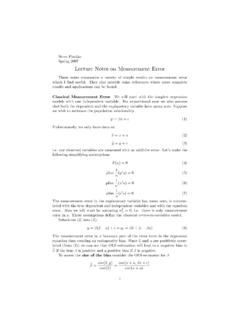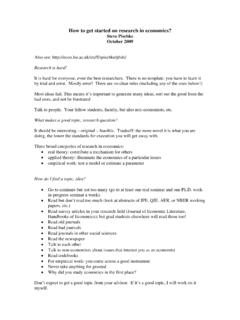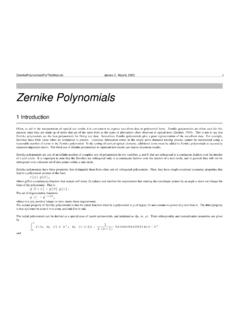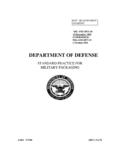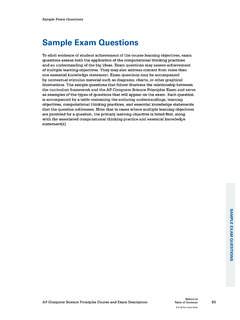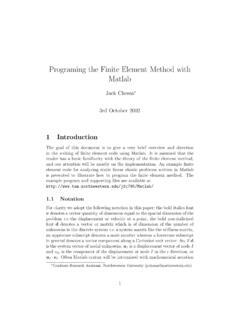Transcription of Lecture Notes on Measurement Error
1 Steve Pischke Spring 2007. Lecture Notes on Measurement Error These Notes summarize a variety of simple results on Measurement Error which I nd useful. They also provide some references where more complete results and applications can be found. Classical Measurement Error We will start with the simplest regression models with one independent variable. For expositional ease we also assume that both the dependent and the explanatory variable have mean zero. Suppose we wish to estimate the population relationship y = x+ (1). Unfortunately, we only have data on e=x+u x (2). ye = y + v (3). our observed variables are measured with an additive Error . Let's make the following simplifying assumptions E(u) = 0 (4).
2 1 0. plim (y u) = 0 (5). n 1. plim (x0 u) = 0 (6). n 1. plim ( 0 u) = 0 (7). n The Measurement Error in the explanatory variable has mean zero, is uncorre- lated with the true dependent and independent variables and with the equation Error . Also we will start by assuming 2v = 0, there is only Measurement Error in x. These assumptions de ne the classical errors-in-variables model. Substitute (2) into (1): y = (e x e+(. u) + = yi = x u) (8). The Measurement Error in x becomes part of the Error term in the regression e and u are positively corre- equation thus creating an endogeneity bias. Since x lated (from (2)) we can see that OLS estimation will lead to a negative bias in b if the true is positive and a positive bias if is negative.
3 To assess the size of the bias consider the OLS-estimator for b = cov(e x; y). =. cov(x + u; x + ). var(e x) var(x + u). 1. and 2. plim b = 2. x 2. =. x + u where 2. x 2 + 2. x u The quantity is referred to as reliability or signal-to-total variance ratio. Since 0 < < 1 the coe cient b will be biased towards zero. This bias is therefore called attenuation bias and is the attenuation factor in this case. The bias is 2. plim b = = (1 ) = 2. u 2. x + u which again brings out the fact that the bias depends on the sign and size of . In order to gure out what happens to the estimated standard Error rst consider estimating the residual variance from the regression b= y bx e=y b (x + u). Add and subtract the true Error = y x from this equation and collect terms.
4 B= (y x) + y bx bu = +( b )x bu You notice that the residual contains two additional sources of variation com- pared to the true Error . The rst is due to the fact that b is biased towards zero. Unlike in the absence of Measurement Error the term b does not vanish asymptotically. The second term is due to the additional variance introduced by the presence of Measurement Error in the regressor. Note that by assumption the three random variables , x, and u in this equation are uncorrelated. We therefore obtain for the estimated variance of the equation Error plim c2 = 2. + (1 )2 2 2. x + 2 2 2. u p For the estimate of the variance of n b , call it sb, we have c2 2. + (1 )2 2 2. + 2 2 2.
5 X u plim sb = plim =. c2 2 + 2. x u e x 2 2 2 2. x x 2 u 2 2. = 2 2 2. + 2 2. (1 )2 + 2 2. x + u x x + u x + u 2. 2 2 2. = 2. + (1 )2 + (1 ). x 2. = s + (1 ). 2. The rst term indicates that the true standard Error is underestimated in pro- portion to . Since the second term is positive we cannot sign the overall bias in the estimated standard Error . However, the t-statistic will be biased downwards. The t-ratio converges to plim t plim b p = p =q n plim sb 2. s + (1 ). p = q 2. s + (1 ). p which is smaller than = s. Simple Extensions Next, consider Measurement Error in the dependent vari- able y, let 2v > 0 while 2u = 0. Substitute (3) into (1): ye = x + + v Since v is uncorrelated with x we can estimate consistently by OLS in this case.
6 Of course, the estimates will be less precise than with perfect data. Return to the case where there is Measurement Error only in x. The fact that Measurement Error in the dependent variable is more innocuous than measure- ment Error in the independent variable might suggest that we run the reverse regression of x on y thus avoiding the bias from Measurement Error . Unfortu- nately, this does not solve the problem. Reverse (8) to obtain 1 1. e=. x y +u u and y are uncorrelated by assumption but y is correlated with the equation Error now. So we have cured the regression of errors-in-variables bias but created an endogeneity problem instead. Note, however, that this regression is still useful because and y are negatively correlated so that 1= d is biased downwards, implying an upward bias for b r = 1= 1= d.
7 Thus the results from the standard regression and from the reverse regression will bracket the true coe cient, plim b < < plim b r . Implicitly, this bracketing result uses the fact that we know that 2 and 2u have to be positive. The bounds of this interval are obtained whenever one of the two variances is zero. This implies that the interval tends to be large when these variances are large. In practice the bracketing result is therefore often not very informative. The bracketing result extends to multivariate regressions: in the case of two regressors you can run the original as well as two reverse regressions. The results will imply that the true ( 1; 2 ) lies inside the triangular area mapped out by these three regressions, and so forth for more regressors [Klepper and Leamer (1984)].
8 3. Another useful fact to notice is that data transformations will typically magnify the Measurement Error problem. Assume you want to estimate the relationship y = x + x2 +. Under normality the attenuation factor for b will be the square of the attenua- tion factor for b [Griliches (1986)]. So what can we do to get consistent estimates of ? If either 2x , 2u , or is known we can make the appropriate adjustment for the bias in . Either one of these is su cient as we can estimate 2 2. x + u (= plim var(e x)) consistently. Such information may come from validation studies of our data. In grouped data estimation, regression on cell means, the sampling Error introduced by the fact that the means are calculated from a sample can be estimated [Deaton (1985)].
9 This only matters if cell sizes are small; grouped data estimation yields consistent estimates with cell sizes going to in nity (but not with the number of cells going to in nity at constant cell sizes). Any instrument z correlated with x but uncorrelated with u will identify the true coe cient since b cov(y; z) cov( x + ; z). IV = =. cov(e x; z) cov(x + u; z). plim b IV =. xz =. xz In this case it is also possible to get a consistent estimate of the population R2 = 2 2x = 2y . The estimator e) b c2 = b cov(y; x R = IV. IV. var(y) b r which is the product of the IV coe cient and the OLS coe cient from the reverse regression, yields 2. c2 =. plim R x = R2. 2. y Get better data. Panel Data Often we are interested in using panel data to eliminate xed e ects.
10 How does Measurement Error a ect the xed e ects estimator? Extend the one variable model in (1) to include a xed e ect: yit = xit + i + it (9). 4. Di erence this to eliminate the xed e ect i. yit yit 1 = (xit xit 1) + it it 1. eit = xit + uit . Using our results from above As before we only observe x 2. plim b = 2. x 2. x+ u So we have to gure out how the variance in the changes of x relates to the variance in the levels. 2. x = var(xt ) 2cov(xt ; xt 1) + var(xt 1). If the process for xt is stationary this simpli es to 2. x = 2 2x 2cov(xt ; xt 1). 2. =2 x (1 ). where is the rst order autocorrelation coe cient in xt . Similarly, de ne r to be the autocorrelation coe cient in ut so we can write 2.




